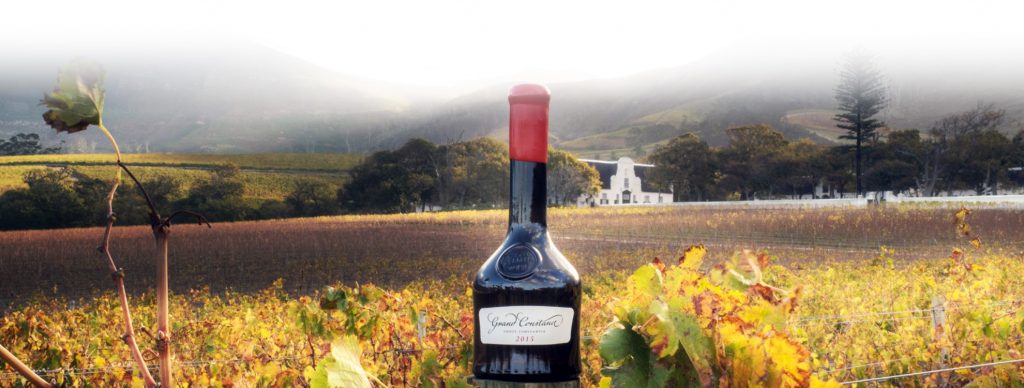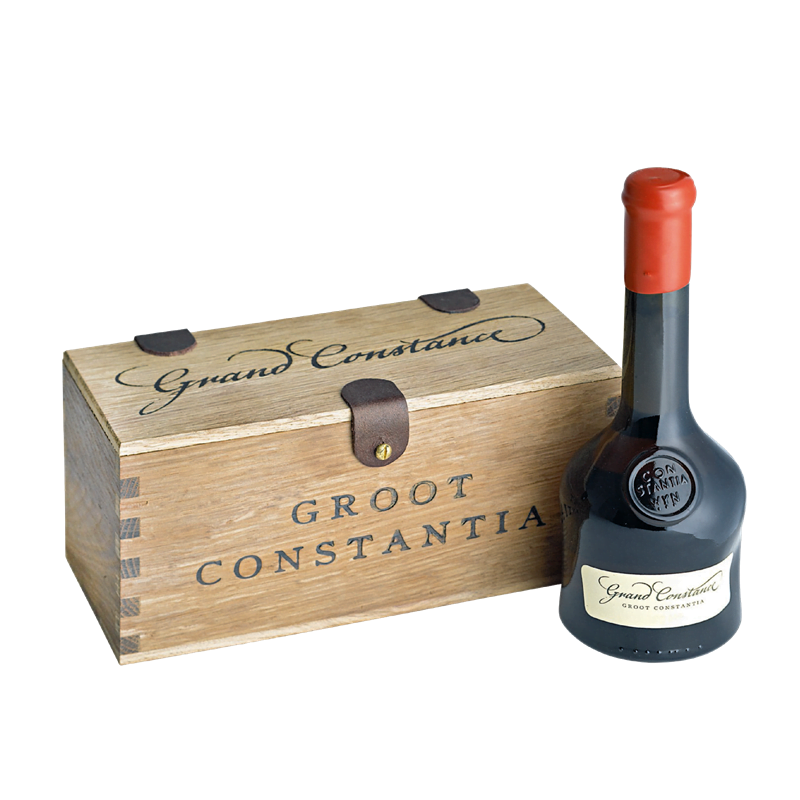OUR LEGACY
GRAND CONSTANCE
Imagine Wine as royalty.
We pride ourselves in the fact that we are producing the finest example of the world-famous
“Constantia Wyn”. It is now known as “GRAND CONSTANCE”.

OUR LEGACY
GRAND CONSTANCE
Imagine Wine as royalty.
We pride ourselves in the fact that we are producing the finest example of the world-famous “Constantia Wyn”. It is now known as “GRAND CONSTANCE”.
The story of the “Constantia Wyn” of Napoleon
Napoleon’s favourite wine originated from “Grand Constance”, the French translation for Groot Constantia. Indeed, The Cloete Cellar, located directly behind Groot Constantia Manor house, produced these wines.
Aside from the usual “Groot Constantia” reference, Groot Constantia used the French translation “Grand Constance” on its labels. It was Grand Constance” that Napoleon drank until his death on Saint Helen’s island in 1821.
At the time, Joseph Luson (1783-1822), an agent of the English East India Company based in Cape Town, provided not only the French contingent at Longwood House, but also the civilian population, the garrison, the regiments stationed on the Island, as well as the ships patrolling the waters around Saint Helena for the British authorities.
Joseph Luson bought the wine directly from the Cloete family who owned Groot Constantia. His business relations with the family changed significantly on 24 May 1817 when he married Catharina Maria (Mary) Cloete, the daughter of Pieter Lourens Cloete, the wine merchant of Groot Constantia, and his wife, Maria Catharina van Reenen. Luson also appointed his brother-in-law, Daniel Jacob Cloete (1800-1879), as his confidential clerk in 1819. Also ‘Den Heer J Luson’ and ‘D J Cloete’ appear among the regular clients recorded in the Groot Constantia Wine Sales Register, meticulously kept between 1800 and 1860..
These wines were all produced and bottled in the famous Cloete Cellar.
Simon van der Stel’s magnificent Homestead and the impressive Cloete Cellar still stand today and form part of the farm Groot Constantia, a Provincial Heritage site and still a fully functional wine estate.

The story of the
“Constantia Wyn”
of Napoleon
Napoleon’s favourite wine originated from “Grand Constance”, the French translation for Groot Constantia. Indeed, The Cloete Cellar, located directly behind Groot Constantia Manor house, produced these wines. Aside from the usual “Groot Constantia” reference, Groot Constantia used the French translation “Grand Constance” on its labels. It was Grand Constance” that Napoleon drank until his death on Saint Helen’s island in 1821.
At the time, Joseph Luson (1783-1822), an agent of the English East India Company based in Cape Town, provided not only the French contingent at Longwood House, but also the civilian population, the garrison, the regiments stationed on the Island, as well as the ships patrolling the waters around Saint Helena for the British authorities.
Joseph Luson bought the wine directly from the Cloete family who owned Groot Constantia. His business relations with the family changed significantly on 24 May 1817 when he married Catharina Maria (Mary) Cloete, the daughter of Pieter Lourens Cloete, the wine merchant of Groot Constantia, and his wife, Maria Catharina van Reenen. Luson also appointed his brother-in-law, Daniel Jacob Cloete (1800-1879), as his confidential clerk in 1819. Also, ‘Den Heer J Luson’ and ‘D J Cloete’ appear among the regular clients recorded in the Groot Constantia Wine Sales Register, meticulously kept between 1800 and 1860.
These wines were all produced and bottled in the famous Cloete Cellar.
Simon van der Stel’s magnificent Homestead and the impressive Cloete Cellar still stand today and form part of the farm Groot Constantia, a Provincial Heritage site and still a fully functional wine estate.

The Grand Constance brand is an important part of World Wine Heritage and South Africa’s oldest wine.
In addition, the rumour is that Napoleon loved the wines made at Groot Constantia, which he enjoyed drinking in exile on Saint Helena between 1815 and 1821.
During the Eighteenth century the sweet wines of Constantia received international acclaim for their superior quality and became known throughout the world as “Constantia Wyn (wine)”. “Constantia wyn” began to fetch extremely high prices at well-attended auctions in many European cities and soon came to rival the sweet wines of Europe.
Also, as Hugh Johnson wrote, “European courts used to prefer Constantia to Yquem, Tokay & Madeira from these Elysian fields in the 18th and 19th centuries.”
Groot Constantia’s rich history shows how one man’s love of wine established South Africa’s first wine farm more than 330 years ago and how those 891 morgen of land formed the origins of the commercial South African wine industry, with Emperors and Kings such as Frederick the Great of Prussia and Louis Phillipe (King of the French) buying ‘Constantia Wyn’ at auctions across Europe. Also, it appears in Jane Austen’s novel Sense and Sensibility as a cure for a broken heart and in Charles Dickens’ story The Mystery of Edwin Drood as a means of lifting a character’s spirits. Perhaps it even soothed Napoleon as it was served during his exile on the island of Saint Helena.

The Grand Constance brand is an important part of World Wine Heritage and South Africa’s oldest wine.
In addition, the rumour is that Napoleon loved the wines made at Groot Constantia, which he enjoyed drinking in exile on Saint Helena between 1815 and 1821.
During the Eighteenth century the sweet wines of Constantia received international acclaim for their superior quality and became known throughout the world as “Constantia Wyn (wine)”. “Constantia wyn” began to fetch extremely high prices at well-attended auctions in many European cities and soon came to rival the sweet wines of Europe.
Also, as Hugh Johnson wrote, “European courts used to prefer Constantia to Yquem, Tokay & Madeira from these Elysian fields in the 18th and 19th centuries.”
Groot Constantia’s rich history shows how one man’s love of wine established South Africa’s first wine farm more than 330 years ago and how those 891 morgens of land formed the origins of the commercial South African wine industry, with Emperors and Kings such as Frederick the Great of Prussia and Louis Phillipe (King of the French) buying ‘Constantia Wyn’ at auctions across Europe. Also, it appears in Jane Austen’s novel Sense and Sensibility as a cure for a broken heart and in Charles Dickens’ story The Mystery of Edwin Drood as a means of lifting a character’s spirits. Perhaps it even soothed Napoleon as it was served during his exile on the island of Saint Helena.
A lost treasure in Delaware Bay

In 2004, Groot Constantia received another significant endorsement when an American citizen picked up a piece of glass on the beach at Lewes, Delaware on the east coast of America.
So, an inscription on a piece of glass, found along with other porcelain items, read “Constantia Wyn.” In 1774, a storm caused the British supply ship the Severn to sink in Delaware Bay, resulting in this artifact. In addition, the wreckage was only discovered in 2004.
Unfortunately, the bottle of Groot Constantia wine was broken during the storm and except for the engraved inscription, the bottle offered no other clue as to what had been inside. It was probably one of the sweet wines that Constantia was known for at that time.
~ Modern Fact ~
Jean Naudé, CEO of the Estate, was invited to a formal
ceremony in Lewes where a certificate signed by the
Secretary of State of Delaware, Harriet Smith
Windsor, was handed to him.
AN EXTRACT FROM THE CERTIFICATE READS
“Because of the broken wine bottle recovered from them‘Severn’
for marketing to the colonies, the State of
Delaware and the Groot Constantia Estate and Winery
will always share an association. In fact, it continues today,
uniquely providing a link to our past, our maritime
heritage and our ties to the sea.”
To commemorate this discovery, the Grand
Constance wine bottle carries a replica of the
inscription on the glass artifact found on the
beach at Lewes. Indeed, A continuation of the world-famous
17th and 18th-century wine of Groot Constantia,
this wine is a continuation of the past.
The accolades received by the Grand Constance
wine affirms that the Groot Constantia Wine
Estate is living up to the vision of our founder,
Simon van der Stel, and upholding his legacy.

~ Modern Fact ~
Jean Naudé, CEO of the Estate, was invited to a formal
ceremony in Lewes where a certificate signed by the
Secretary of State of Delaware, Harriet Smith
Windsor, was handed to him.
AN EXTRACT FROM THE CERTIFICATE READS
“Because of the broken wine bottle recovered from them‘Severn’ for marketing to the colonies, the State of Delaware and the Groot Constantia Estate and Winery will always share an association. It continues today, uniquely providing a link to our past, our maritime heritage and our ties to the sea.”

To commemorate this discovery, the Grand
Constance wine bottle carries a replica of the
inscription on the glass artifact found on the
beach at Lewes. A continuation of the
world-famous 17th and 18th-century wine of Groot Constantia, this wine is a continuation of the past.
The accolades received by the Grand Constance
wine affirm that the Groot Constantia Wine
Estate is living up to the vision of our founder,
Simon van der Stel, and upholding his legacy.


The Award-winning Groot Constantia Grand Constance Wine
“Monde Selection International Wine Contest” in Brussels awarded the 2012 and 2013 Grand Constance top awards. Furthermore, this Monde judging panel, which is made up of over 70 totally independent judges consisting of Michelin-starred chefs and master sommeliers, amongst other experts, judged wines from 26 different countries.. Also, Groot Constantia’s Grand Constance won the Gold Award from Monde, which goes to products that achieve an average result between 80% and 89%.
Adding to this success, the 2013 Grand Constance was also selected as one of the Top 100 SA Wines in 2016; and named as best in its class.
The 2013 Grand Constance continued to gather awards at the Decanter Asia Wine Awards, earning the highest accolade. Indeed, having achieved 98 out of 100 possible points, Grand Constance received Platinum for being the Best South African Sweet Wine. Also, The Grand Constance 2014 was awarded a Gold Medal and a position in the Top 10 Muscats in the World list at the 17th annual Muscats du Monde wine competition.

The Award-winning Groot Constantia Grand Constance Wine
“Monde Selection International Wine Contest” in Brussels awarded the 2012 and 2013 Grand Constance top awards. Furthermore, this Monde judging panel, which is made up of over 70 totally independent judges consisting of Michelin-starred chefs and master sommeliers, amongst other experts, judged wines from 26 different countries.. Also, Groot Constantia’s Grand Constance won the Gold Award from Monde, which goes to products that achieve an average result between 80% and 89%.
Adding to this success, the 2013 Grand Constance was also selected as one of the Top 100 SA Wines in 2016; and named as best in its class.
The 2013 Grand Constance continued to gather awards at the Decanter Asia Wine Awards, earning the highest accolade. Indeed, having achieved 98 out of 100 possible points, Grand Constance received Platinum for being the Best South African Sweet Wine. Also, The Grand Constance 2014 was awarded a Gold Medal and a position in the Top 10 Muscats in the World list at the 17th annual Muscats du Monde wine competition.

